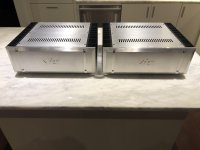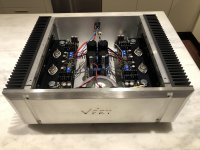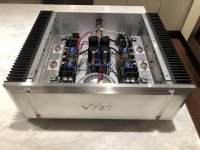mark my words .......
I have been really looking forward to that amp if it is what I think it is going to be.
I might point out to those not au fait with the vernacular, "you bloody bastard" said in this way can be rather affectionate and basically means "I envy you and I'm jealous!" It's not an insult at all, it's an Oz cultural thing...You bloody bastard.
Hahahahaha
Don't tell them that.
I want them to think I am bloody cursing those bloody bastards.
Don't tell them that.
I want them to think I am bloody cursing those bloody bastards.
After more than a year of on/off working on the Vfet amps, I finally finished the 2 monoblocks.
My heartfelt thanks to Mr. Pass for sharing with us these designs and guiding us in their build.
The Vfet threads, among many others, are a treasure trove of tips and advice and I most certainly wouldn't have been able to complete the amps without reading what so many of you have posted.
As a tribute to Mr. Pass' original Vfet, I decided I would try to replicate the faceplate (it is by no means meant to be a knockoff).
It's the first time I try my hand at finishing aluminum, and as you can see from the top plate and faceplate, my success was equivocal. No local anodizing place had any interest in anodizing my DIY chassis parts, therefore I tried protecting the aluminum by using Alodine 1001. First and last time I'm getting anywhere near that solution; it's quite toxic.
I wasn't able to find another pair of T-brackets for the second monoblock, therefore I used L angles. The problem is that the surface finishing isn't very smooth. To compensate I tried using some keratherm red for the Vfet. The Vfet case temperatures rise to about 54C with the chassis closed after about 1.5h. The case temperatures for the amp with the T-brackets get to about 50C.
As for the sound, I haven't been able to listen for too long, but on first impression, after they warm up, the sound puts a huge smile on my face. It's very detailed yet also smooth. The soundstage is very wide and deep. My speakers only have a sensitivity of 86 dB/2.8V/1m and the listening room is pretty big, but the amps have no problem driving them to pretty loud levels.
I always appreciate seeing other builder's creations, so here is my attempt.
Paul
My heartfelt thanks to Mr. Pass for sharing with us these designs and guiding us in their build.
The Vfet threads, among many others, are a treasure trove of tips and advice and I most certainly wouldn't have been able to complete the amps without reading what so many of you have posted.
As a tribute to Mr. Pass' original Vfet, I decided I would try to replicate the faceplate (it is by no means meant to be a knockoff).
It's the first time I try my hand at finishing aluminum, and as you can see from the top plate and faceplate, my success was equivocal. No local anodizing place had any interest in anodizing my DIY chassis parts, therefore I tried protecting the aluminum by using Alodine 1001. First and last time I'm getting anywhere near that solution; it's quite toxic.
I wasn't able to find another pair of T-brackets for the second monoblock, therefore I used L angles. The problem is that the surface finishing isn't very smooth. To compensate I tried using some keratherm red for the Vfet. The Vfet case temperatures rise to about 54C with the chassis closed after about 1.5h. The case temperatures for the amp with the T-brackets get to about 50C.
As for the sound, I haven't been able to listen for too long, but on first impression, after they warm up, the sound puts a huge smile on my face. It's very detailed yet also smooth. The soundstage is very wide and deep. My speakers only have a sensitivity of 86 dB/2.8V/1m and the listening room is pretty big, but the amps have no problem driving them to pretty loud levels.
I always appreciate seeing other builder's creations, so here is my attempt.
Paul
Attachments
Congratulations Paul ! Those mono blocks look stunning both on the inside and the outside [emoji4]
Pass DIY Addict
Joined 2000
Paid Member
Paul,
Outstanding. Not to mention the improved measurements if a balanced source is used since you are cancelling the 2nd order harmonic with your build. I figure for an 8 ohm load... you should get about 30 watts at 1% THD? Output impedance should rise to 0.36 ohms or a damping factor of 22.5. I hope you enjoy this build for years to come.
Best,
Anand.
Outstanding. Not to mention the improved measurements if a balanced source is used since you are cancelling the 2nd order harmonic with your build. I figure for an 8 ohm load... you should get about 30 watts at 1% THD? Output impedance should rise to 0.36 ohms or a damping factor of 22.5. I hope you enjoy this build for years to come.
Best,
Anand.
Last edited:
Paul, and others who've designed faceplates thicker than 10mm, did you CNC the front panels yourself, or are there shops out there who will machine larger pieces? Front Panel Express and Modushop both max out at 10mm. Does anyone have recommendations for other machining services that can work with 15 or 20mm designs?
- Home
- Amplifiers
- Pass Labs
- Sony vFET Illustrated build guide





